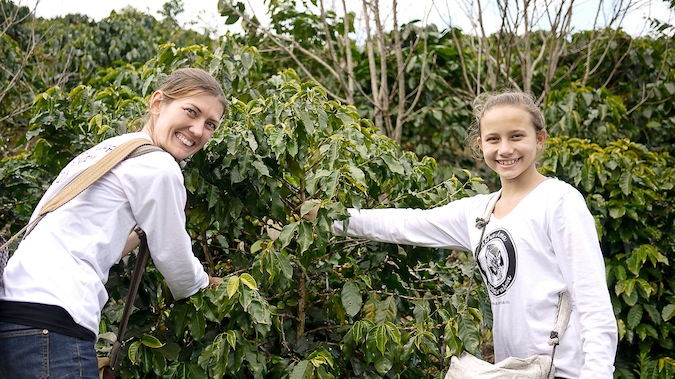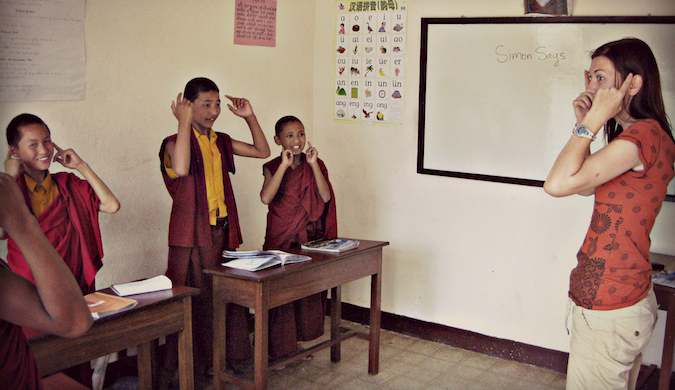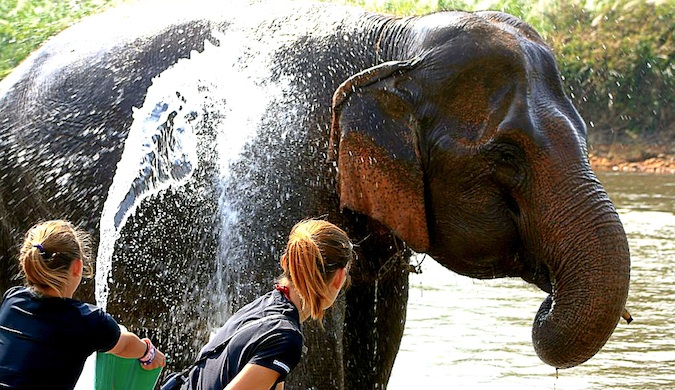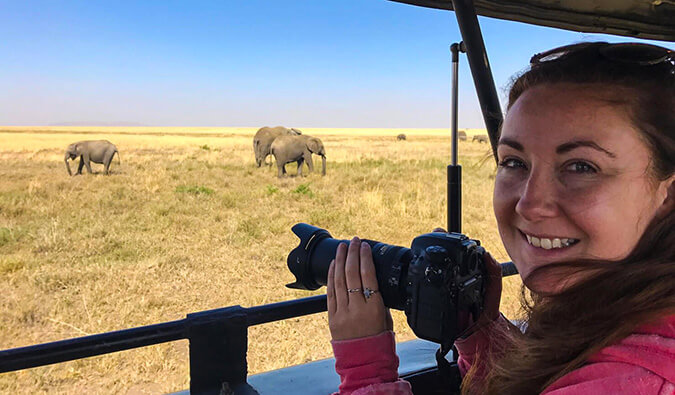
Posted: 1/31/2013 | January 31st, 2013
I’m frequently asked about volunteering overseas, and unfortunately I don’t know much about it. So today, I’m turning the blog over to friend and volunteer tourism expert Shannon O’Donnell from the blog A Little Adrift. She’s been volunteering around the world for years and recently published a book on the subject. She’s the expert, so without further ado, here’s Shannon’s advice on finding good volunteer opportunities.
A foundational motivation underpinning the past four years I’ve been traveling around the world has been the idea that serving others would help me find clearer direction for my life. There are many ways to better understand and respect other cultures as we travel, but for me, the most effective has been volunteering.
I left home to travel for many reasons, and I had many preconceived ideas about what I would find outside the confines of the United States. Traveling dispelled many of those notions almost immediately, but it was only when I slowed down and spent time volunteering that I was able to sink into the travel experience in a way that goes beyond photographing the major temples, churches, and iconic sites.
When I first left in 2008 on what I thought would simply be a year-long round-the-world trip, I was overwhelmed by how convoluted and ethically ambiguous the international volunteer industry seemed. Simple searches to find projects I could support on my trip yielded a bevy of companies touting volunteer experiences in the poorest countries in the world and yet costing many thousands of dollars — it didn’t make sense, and it nearly discouraged me from doing any work at all.
But once I traveled, researched, and learned, I realized there are many quality, ethical options out there for travelers interested in volunteering, but finding them is tougher than it should be. It’s this quandary that motivated me to write my book, The Volunteer Traveler’s Handbook.
I know what it’s like to want to volunteer and travel but to be confused by the sometimes huge fees, the equivocal ethics, and the sheer number of options. With that in mind, I jumped at the opportunity Matt gave me to share five clear steps on how to find and vet good-fit volunteer projects.
Step One: Understand Development and Aid
During my first year volunteering internationally, I overlooked this first step and instead fueled my volunteer efforts with enthusiasm and little knowledge, and, as a result, I, unfortunately, supported a few projects that I now see had fundamental ethical issues. One of the hardest things for new, eager volunteers to understand is that not all organizations — even nonprofits — are doing good, necessary work that ethically develops the communities and ecosystems where we volunteer our time. For that reason, take a step back from the planning and instead learn more about core problems facing development projects when they bring in Western volunteers and ideas.
Two core themes I analyze in my book center on how too many volunteer projects can actually foster dependency on international aid and compromise the dignity of the people they are trying to help. Before you volunteer, your job is to understand the macro-industry around volunteering. I’ve collected a list of fantastic books, TED Talks, and websites that provide context for international aid conundrums and the interplay between volunteering and development work. Each one of these three books and articles offers a good start toward broad-level understanding:
- The Elusive Quest for Growth by William R. Easterly: nicely frames the major, core issues of international development models
- The Bottom Billion: Why the Poorest Countries are Failing and What Can Be Done About It by Paul Collier: an easy read and great overall look at development; he presents interesting solutions to major aid issues.
- “It Doesn’t Take a Village: The perverse effects of local aid”: this Economist article analyzes the idea that empowerment at the local level is best, countering with arguments of corruption, elitism, and bureaucratic issues. The article illustrates that there is no panacea for the major development issues.
Step Two: Choose a Good-Fit Type of Volunteering
There are an overwhelming number of ways to volunteer, and since I started traveling more than four years ago, I’ve tried most of them. I used a placement company on my round-the-world trip to find a monastery in Nepal where I could teach, I’ve taken recommendations from travelers on the road, and now I most often volunteer independently with small organizations I find organically as I travel. Your next step is to assess your time commitment and your personal volunteer motivations.
- Independent volunteering: Independent volunteering is ideal for long-term travelers and those on a flexible round-the-world trip who don’t know when or where they might be traveling. There’s usually little or no facilitation, so you must arrange all travel, accommodation, and food. In exchange, the fees are low or free. You’re traditionally working directly with the project or organization on a very hands-on level.
- Placement companies: Middlemen take a fee to match you with a specific type of volunteer project and usually offer a medium level of facilitation. Ideal for very specific or niche volunteer experiences and either short or long time commitments.
- Voluntours: These offer a high level of facilitation and are ideal for those on a short vacation who want to pack in a lot of sites with a nod to service integrated into the trip. Voluntours are expensive, and the ratio of touring to service can vary greatly. Usually, the bulk of your fee goes to the tour company itself.
- Social enterprises: All travelers can support the small businesses working in their own local communities for change. If you can only volunteer for a very short time, consider nixing the volunteering and instead infusing your money into local communities as you travel. Volunteering is not always the right choice on every trip, but you can still do good by choosing restaurants, shops, and business with an underlying social mission.
Step Three: Research Organizations in Your Interest Area
Now we’re down to the nitty-gritty details. Travelers too often skip the first two steps and risk having an unfulfilling trip at best and doing harm with their volunteering efforts at worst. My prep work for a new volunteer trip starts with a search of the major volunteer databases to see what projects exist in my interest area. I then use a spreadsheet or an Evernote folder to track the details.
These websites allow you to sort and sift through the whole gamut of types of volunteering (conservation, teaching, medical, etc.) and requirements (family, timing, location). For now, simply fill your spreadsheet or folder with projects that excite you, and in the next step we’ll look at vetting potential volunteer projects.
- Go Overseas: This site collates volunteering placements from many companies and returns a lot of variety in the search results.
- Idealist.org: A large database that occasionally returns some fantastic, small, niche organizations.
- Pro World: A wonderful middleman placement company with community-driven projects and offering internships, volunteering, and study-abroad programs.
- Volunteer HQ: Very fair placement fees even with the refundable registration fee taken into account, and they seem to choose projects with a long-term community approach.
- WWOOF: Working on organic farms is a wonderful way to give time to farm, agriculture, and sometimes conservation projects. (Matt has previously provided a full guide on how to WWOOF on your travels.)
Step Four: Ask the Right Questions
Vetting the volunteer projects you researched is your next step and allows you to narrow your list. Diligently follow through with this stage of the process because there are heartbreaking consequences to supporting projects that are not sensitive to the needs of the people and places they serve. An example— and a cautionary tale — is the current orphanage scandals reported in Africa and Cambodia; something as innocuous as volunteering at an orphanage often has sad and heartbreaking side effects on the children.
Frustratingly, there are disparate issues within each volunteering niche, so I wrote up a full list of questions to ask your volunteer organization on my volunteer site. The core issues most volunteer projects face come down to:
- Where is the money going? Look at placement fees and how much of that fee goes back into the community or projects.
- How is the organization working with the community? Have they asked the local community if this project is something that is wanted or needed? Find out if the organization is prepared to stick around and support the project or development work for potentially many years if that is needed, or leave altogether if not.
- What is expected of volunteers? What is the exact nature of the volunteer work, and what is the level of volunteer support on the ground?
When you’ve effectively questioned the organizations and projects that interest you, you’re only left with the personal decision of weighing time, costs, and project details to decide which one fits your volunteering goals. My 11-year-old niece and I volunteered during our seven-month trip to Southeast Asia, and my volunteer goals then were quite different than when I travel solo. My various projects over the years have reflected my differing circumstances…as will yours!
Step Five: Take a Deep Breath
The single decision to weave international service into my round-the-world travels changed the direction of my life. I left the US back in 2008 confused about the direction I should take. I left behind my previous dreams as an actor in Los Angeles and hoped that travel and volunteering would help me refocus. It has done that and more: the regular integration of service in my life gave me a new lens through which to experience the world and an ability to experience communities and cultures in a way that simply traveling through a country does not.
Once you’ve picked your volunteer experience, take a deep breath before you tackle the planning phase and those practicalities. I have travel resources and volunteer resources when you’re ready for that, but pause first. It’s easy to get bogged down in the details, but the larger picture is very rewarding when you’re able to sit down in the airplane — your bags packed, vaccinations done, details planned — and simply anticipate the new experiences and perspectives you’re about to face.
Shannon O’Donnell has been traveling the world since 2008; she travels slowly and volunteers in small communities along the way. She recently published The Volunteer Traveler’s Handbook, and her travel stories and photography are recorded on her travel blog, A Little Adrift.
Book Your Trip: Logistical Tips and Tricks
Book Your Flight
Find a cheap flight by using Skyscanner. It’s my favorite search engine because it searches websites and airlines around the globe so you always know no stone is being left unturned.
Book Your Accommodation
You can book your hostel with Hostelworld. If you want to stay somewhere other than a hostel, use Booking.com as it consistently returns the cheapest rates for guesthouses and hotels.
Don’t Forget Travel Insurance
Travel insurance will protect you against illness, injury, theft, and cancellations. It’s comprehensive protection in case anything goes wrong. I never go on a trip without it as I’ve had to use it many times in the past. My favorite companies that offer the best service and value are:
- SafetyWing (best for everyone)
- Insure My Trip (for those 70 and over)
- Medjet (for additional evacuation coverage)
Want to Travel for Free?
Travel credit cards allow you to earn points that can be redeemed for free flights and accommodation — all without any extra spending. Check out my guide to picking the right card and my current favorites to get started and see the latest best deals.
Need Help Finding Activities for Your Trip?
Get Your Guide is a huge online marketplace where you can find cool walking tours, fun excursions, skip-the-line tickets, private guides, and more.
Ready to Book Your Trip?
Check out my resource page for the best companies to use when you travel. I list all the ones I use when I travel. They are the best in class and you can’t go wrong using them on your trip.





